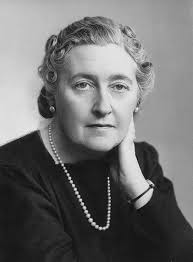
Why Didn’t They Ask Evans?
Two amateur detectives springing into action to crack a murder case is no extraordinary tale; what sets this book apart is how the title of the book fits into the narrative, revealing an answer so simple that it left us in shock, and then admiration for the author. First published in 1934, we didn’t miss Hercule Poirot much in this outing because of the endearing antics of the two protagonists, Bobby Jones and Lady Derwent, who faintly reminded us of Tommy and Tuppence.

The Murder of Roger Ackroyd
Wealthy Roger Ackroyd of the village of King’s Abbot passes away suddenly and who happens to be cultivating marrows in the village but his neighbour friend and our favourite Hercule Poirot! The retired detective is forced to reveal his identity and step in, much to our delight. A compelling read from start to finish, this book is an all-time favourite because of the last chapter which turns the plot on its head. It remains one of the most diabolic plot-twists in murder mysteries.

A Murder Is Announced
Considered Miss Marple’s finest hour, A Murder is Announced created ripples when it was published in 1950. What sets out to be a joke with an announcement in the local gazette claiming to announce an impending murder at Little Paddocks turns gruesome with the death of the supposed perpetrator. A series of trademark Christie twists and turns later, we discover multiple subplots and motives. A Christie classic, this Miss Marple book had even hardcore Poirot fans nodding in excitement.

The ABC Murders
This novel has a forewarned Poirot unable to prevent the death of Alice Ascher, Betty Barnard and Carmichael Clarke. In a first-of-its-kind ‘serial killer’ novels, the joy is in watching Poirot trying to prevent the killer from reaching ‘D’. An experiment in narration, flitting between first-person and third-person, Christie sharpens her claws with this. What we love best is that the novel has one of the most misleading clues in the history of red herrings.

Endless Night
‘Every night and every morn,
Some to misery are born.
Every morn, every night
Some are born to sweet delight,
Some are born to sweet delight,
Some are born to endless night’
These lines by William Blake act as the beginning of the book that Christie herself considered her favourite and also proved her prowess as not only a great thinker but also a great writer. It’s a mystery that is slowly and gently revealed when the reader is halfway through the book. The way the characters are built to create an atmosphere similar to Wuthering Heights is fantastic.

Curtain: Poirot’s Last Case
Hercule Poirot and Hastings come full circle in Poirot’s last case which brings them back to the setting of A Mysterious Affair at Styles, where it all began! An arthritis-stricken Poirot is dependent on a wheelchair, a butler and heavy doses of morphine. Delivering justice in a way befitting the great detective, the book is the closing chapter of the entire series, ending with the death of the genius.

Murder At The Vicarage
The first time Christie announces the old, genteel, meek character of Miss Marple in a novel format, is in this book, for she had previously appeared in two short stories. Readers experience who she really is as she goes about effortlessly solving a crime. Murder At The Vicarage is about the most-hated man in town, Colonel Lucius Protheroe, whose death would be a welcome for the townsfolk, as publicly admitted by the town vicar. However, when the man actually ends up dead, there are multiple suspects and two confessors. The book was adapted into a play, a film by BBC and a graphic novel by Harper Collins.

Death on the Nile
A couple trying to escape the husband’s former lover book a ticket for a cruise on the Nile. The lover follows suit with Poirot in tow. Soon people start getting killed on the cruise and it is up to the Belgian sleuth to piece together the seemingly unrelated deaths, which also includes the unfortunate wife. And in typical Agatha Christie style, we are led to think that the mystery has been solved, while the truth is a lot more twisted. Cairo and our dreams of cruising down the Nile on a full moon night have never been the same again!

A BRAND-NEW THRILLER THAT BRINGS POIROT BACK
Sophie Hannah’s The Mystery of Three Quarters is her third attempt at bringing Agatha Christie’s much-loved detective, Hercule Poirot, back to life. After The Monogrammed Murders and Closed Casket, this time Hannah sets the plot around the mysterious death of a certain Barnabas Pandy. However, it is not the death that is intriguing, for the old man might have died of natural causes in his bathtub, it is what follows three months after the incident.
A furious Sylvia Rule accosts Poirot outside his house asking for an explanation behind a letter of accusation for the murder of Pandy, undersigned by Poirot. Our infallible detective has neither heard of a Sylvia Rule or a Barnabas Pandy till that very moment. Soon, there are three more people added to the list, who receive accusatory letters from Poirot supposedly, for the murder of Pandy.
Setting the theme of the story in the ‘First Quarter’, Hannah’s ode to Christie is filled with the right amount of “grey cell” references and has us almost convinced that the Belgian detective is back!
She has kept his idiosyncrasies and quirks intact in this novel set in 1930s England. Narrated by Scotland Yard Inspector Edward Catchpool, reminiscent of dear old Hastings, here Poirot wades through multiple red herrings to figure who sent the letters. Why did they name him? How are these four strangers connected?
The ample plot-twists native to Christie are missing in this one, but certain shoes are just too large to fill.
OUR FAVE POIROT AND MISS MARPLE ON SCREEN
We can’t celebrate Agatha Christie’s birthday without remembering the talented actors who brought her characters alive on screen.
For Poirot, our top pick would be David Suchet, who played the part from 1989 to 2013 in the ITV series Agatha Christie’s Poirot. Many of us have grown up spending our Sunday mornings glued to the TV — Doordarshan, back in the ’80s! — watching Suchet unleash his antics, wit and intelligence in equal measure as the diminutive and observant Hercule Poirot. Not to forget his signature moustache and that inimitable French-meets-Belgium accent.
Our favourite Miss Marple is much closer to home and it’s none other than Rakhee as Ranga Pishima in the 2003 film Shubha Mahurat — Rituparno Ghosh’s adaptation of The Mirror Crack’d from Side to Side.
Much like Christie’s Miss Marple, Ranga Pishima is a caring, homely person whose watchful eyes miss nothing. While Miss Marple had her garden, our Ranga Pishima has her kittens. And Rakhee brought so much to the character with her sharp, flinty mind behind that soft, endearing appearance.











